2023 HYUNDAI NEXO wheel
[x] Cancel search: wheelPage 491 of 558
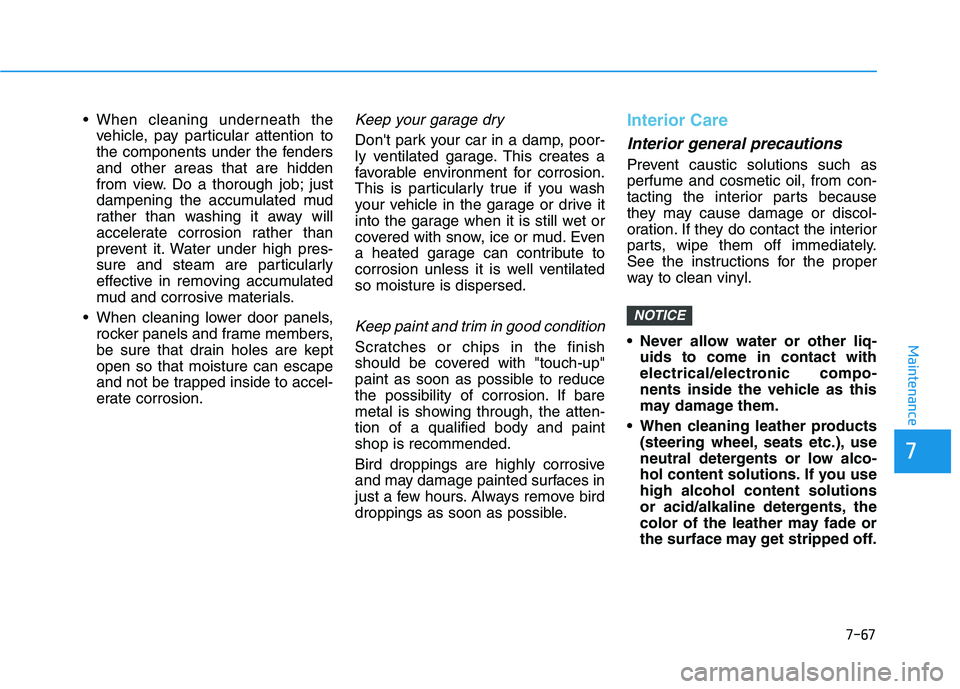
7-67
7
Maintenance
vehicle, pay particular attention to
the components under the fendersand other areas that are hidden
from view. Do a thorough job; just
dampening the accumulated mud
rather than washing it away will
accelerate corrosion rather than
prevent it. Water under high pres-
sure and steam are particularly
effective in removing accumulated
mud and corrosive materials.
When cleaning lower door panels, rocker panels and frame members,
be sure that drain holes are keptopen so that moisture can escape
and not be trapped inside to accel-
erate corrosion.Keep your garage dry
Don't park your car in a damp, poor-
ly ventilated garage. This creates a
favorable environment for corrosion.
This is particularly true if you wash
your vehicle in the garage or drive it
into the garage when it is still wet or
covered with snow, ice or mud. Even
a heated garage can contribute to
corrosion unless it is well ventilatedso moisture is dispersed.
Keep paint and trim in good condition
Scratches or chips in the finish
should be covered with "touch-up"
paint as soon as possible to reduce
the possibility of corrosion. If bare
metal is showing through, the atten-tion of a qualified body and paintshop is recommended.
Bird droppings are highly corrosive
and may damage painted surfaces in
just a few hours. Always remove bird
droppings as soon as possible.
Interior Care
Interior general precautions
Prevent caustic solutions such as perfume and cosmetic oil, from con-
tacting the interior parts because
they may cause damage or discol-
oration. If they do contact the interior
parts, wipe them off immediately.
See the instructions for the proper
way to clean vinyl.
Never allow water or other liq-uids to come in contact with
electrical/electronic compo-
nents inside the vehicle as this
may damage them.
When cleaning leather products (steering wheel, seats etc.), use
neutral detergents or low alco-
hol content solutions. If you usehigh alcohol content solutions
or acid/alkaline detergents, the
color of the leather may fade or
the surface may get stripped off.
NOTICE
Page 494 of 558
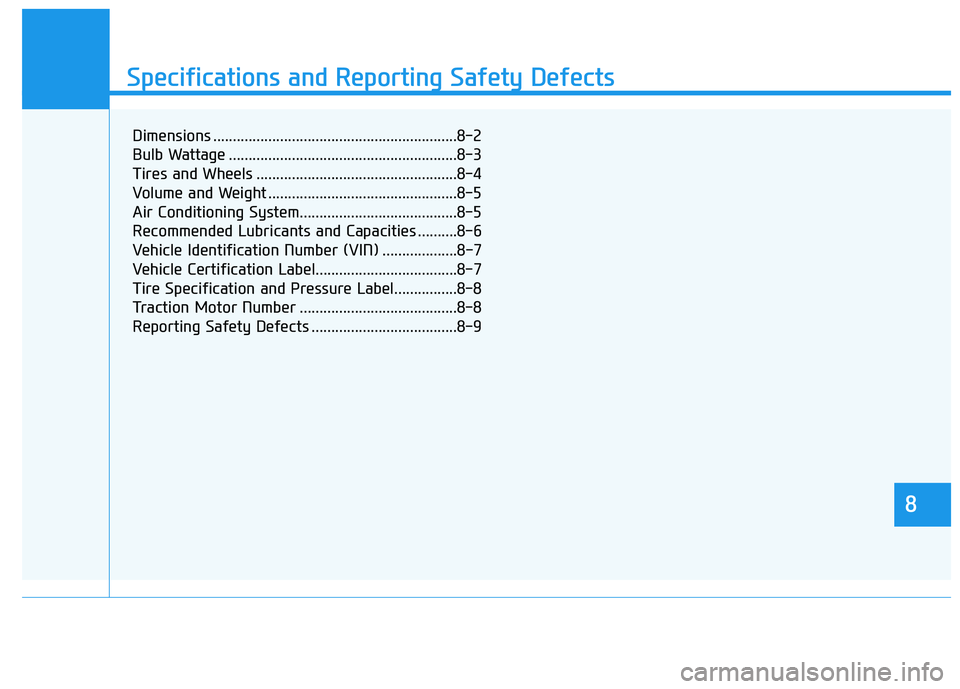
888
Specifications & Consumer information
8
Specifications and Reporting Safety Defects
8
Dimensions ..............................................................8-2
Bulb Wattage ..........................................................8-3
Tires and Wheels ...................................................8-4
Volume and Weight ................................................8-5
Air Conditioning System........................................8-5
Recommended Lubricants and Capacities ..........8-6
Vehicle Identification Number (VIN) ...................8-7
Vehicle Certification Label....................................8-7
Tire Specification and Pressure Label................8-8
Traction Motor Number ........................................8-8
Reporting Safety Defects .....................................8-9
Page 495 of 558

DDIIMM EENN SSIIOO NNSS
8-2
Specifications and Reporting Safety Defects
Itemsmm (in)
Overall length4,670 (183.86)
Overall width1,860 (73.23)
Overall heightWithout roof side rails : 1,630 (64.17)
With roof side rails : 1,640 (64.57)
Front tread225/60 R171,618 (63.70)
245/45 R191,614 (63.54)
Rear tread 225/60 R171,629 (64.13)
245/45 R191,625 (63.98)
Wheelbase2,790 (109.84)
Page 497 of 558
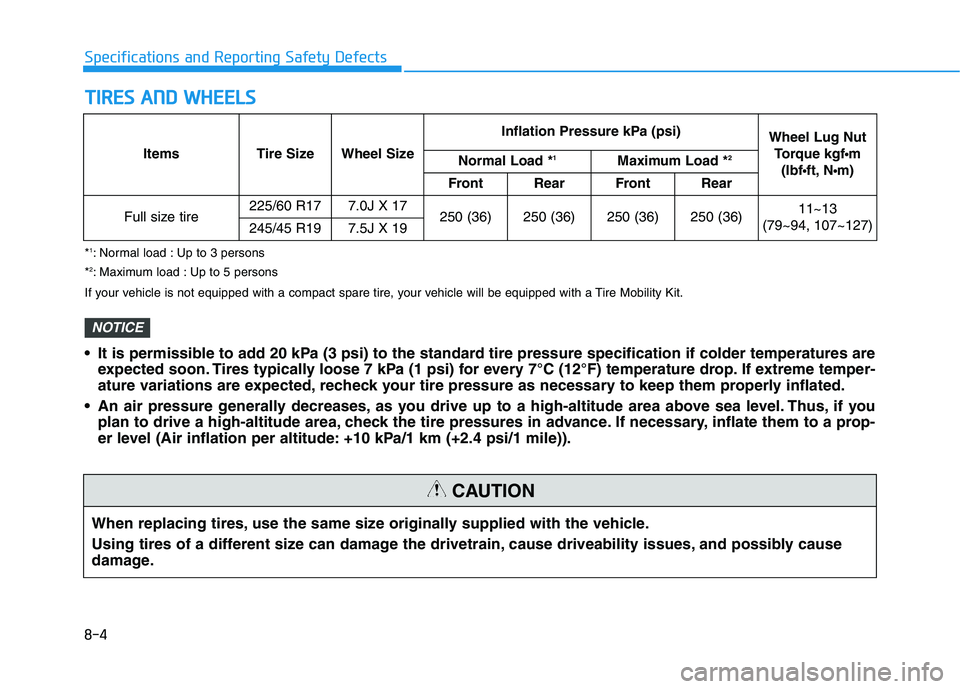
8-4
Specifications and Reporting Safety DefectsT
T IIRR EESS AA NN DD WW HHEEEELLSS
When replacing tires, use the same size originally supplied with the vehicle.
Using tires of a different size can damage the drivetrain, cause driveability issues, and possibly cause
damage.
CAUTION
If your vehicle is not equipped with a compact spare tire, your vehicle will be equipped with a Tire Mobility Kit.
Items Tire SizeWheel Size
Inflation Pressure kPa (psi)Wheel Lug Nut
Torque kgf •m
(lbf ft, N m)
Normal Load * 1Maximum Load * 2
FrontRearFrontRear
Full size tire225/60 R177.0J X 17250 (36)250 (36)250 (36)250 (36)11~13
(79~94, 107~127)
245/45 R197.5J X 19
It is permissible to add 20 kPa (3 psi) to the standard tire pressure specification if colder temperatures are expected soon. Tires typically loose 7 kPa (1 psi) for every 7°C (12°F) temperature drop. If extreme temper-
ature variations are expected, recheck your tire pressure as necessary to keep them properly inflated.
An air pressure generally decreases, as you drive up to a high-altitude area above sea level. Thus, if you plan to drive a high-altitude area, check the tire pressures in advance. If necessary, inflate them to a prop-
er level (Air inflation per altitude: +10 kPa/1 km (+2.4 psi/1 mile)).
NOTICE
*1
: Normal load : Up to 3 persons
* 2
: Maximum load : Up to 5 persons
Page 537 of 558
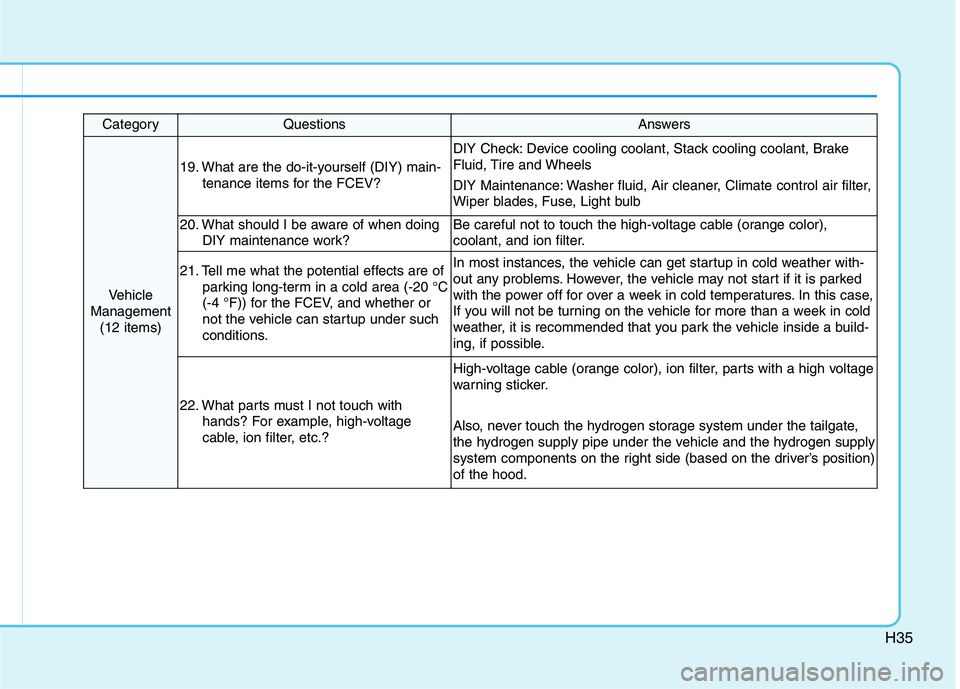
H35
CategoryQuestionsAnswers
Vehicle
Management (12 items)
19. What are the do-it-yourself (DIY) main-
tenance items for the FCEV?
DIY Check: Device cooling coolant, Stack cooling coolant, Brake
Fluid, Tire and Wheels
DIY Maintenance: Washer fluid, Air cleaner, Climate control air filter,
Wiper blades, Fuse, Light bulb
20. What should I be aware of when doingDIY maintenance work?Be careful not to touch the high-voltage cable (orange color),
coolant, and ion filter.
21. Tell me what the potential effects are ofparking long-term in a cold area (-20 °C
(-4 °F)) for the FCEV, and whether or
not the vehicle can startup under such
conditions.In most instances, the vehicle can get startup in cold weather with-
out any problems. However, the vehicle may not start if it is parked
with the power off for over a week in cold temperatures. In this case,
If you will not be turning on the vehicle for more than a week in cold
weather, it is recommended that you park the vehicle inside a build-
ing, if possible.
22. What parts must I not touch with
hands? For example, high-voltage
cable, ion filter, etc.?
High-voltage cable (orange color), ion filter, parts with a high voltage
warning sticker.
Also, never touch the hydrogen storage system under the tailgate,
the hydrogen supply pipe under the vehicle and the hydrogen supply
system components on the right side (based on the driver’s position)of the hood.
Page 546 of 558
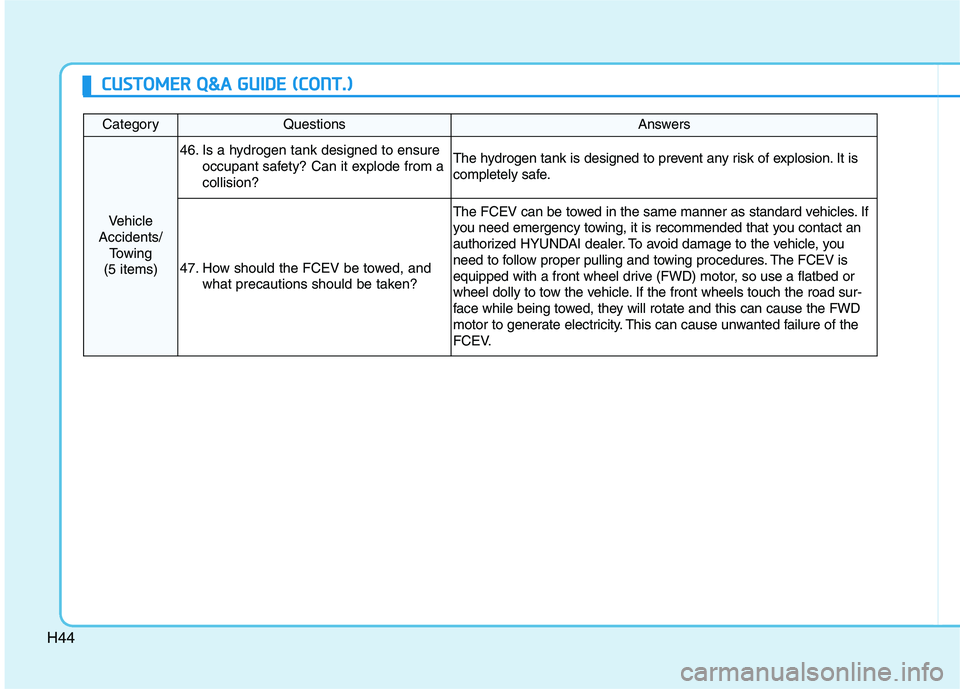
H44
CategoryQuestionsAnswers
Vehicle
Accidents/
Towing
(5 items)
46. Is a hydrogen tank designed to ensure occupant safety? Can it explode from a collision?The hydrogen tank is designed to prevent any risk of explosion. It is
completely safe.
47. How should the FCEV be towed, andwhat precautions should be taken?
The FCEV can be towed in the same manner as standard vehicles. If
you need emergency towing, it is recommended that you contact an
authorized HYUNDAI dealer. To avoid damage to the vehicle, you
need to follow proper pulling and towing procedures. The FCEV is
equipped with a front wheel drive (FWD) motor, so use a flatbed or
wheel dolly to tow the vehicle. If the front wheels touch the road sur-
face while being towed, they will rotate and this can cause the FWD
motor to generate electricity. This can cause unwanted failure of the
FCEV.
CCUU SSTT OO MM EERR QQ &&AA GG UU IIDD EE (( CC OO NNTT..))
Page 552 of 558
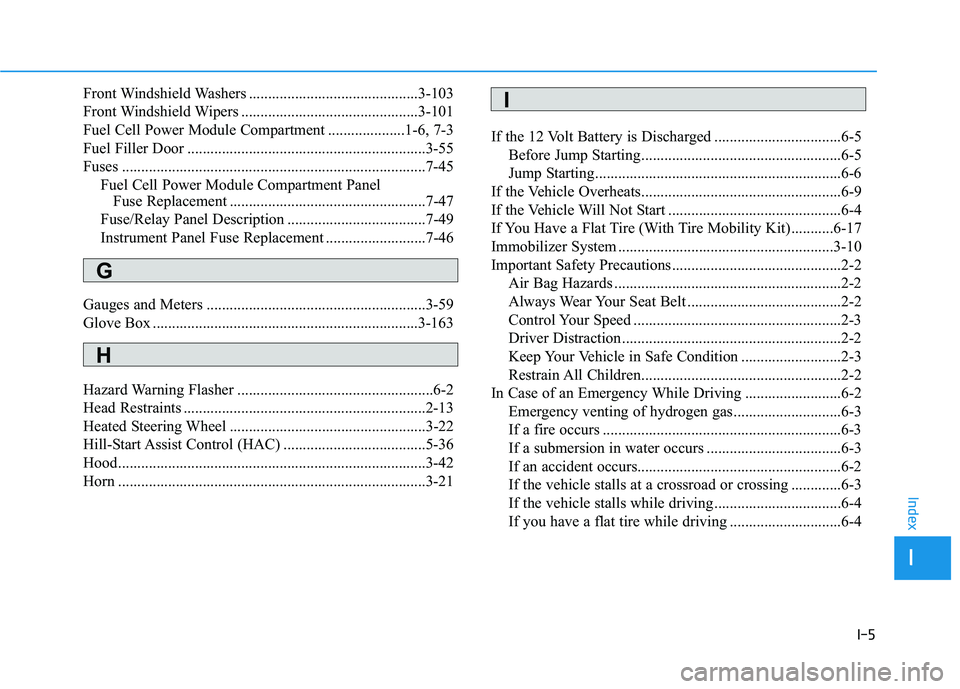
I-5
Front Windshield Washers ............................................3-103
Front Windshield Wipers ..............................................3-101
Fuel Cell Power Module Compartment ....................1-6, 7-3
Fuel Filler Door ..............................................................3-55
Fuses ...............................................................................7-45
Fuel Cell Power Module Compartment Panel Fuse Replacement ...................................................7-47
Fuse/Relay Panel Description ....................................7-49
Instrument Panel Fuse Replacement ..........................7-46
Gauges and Meters .........................................................3-59
Glove Box .....................................................................3-163
Hazard Warning Flasher ...................................................6-2
Head Restraints ...............................................................2-13
Heated Steering Wheel ...................................................3-22
Hill-Start Assist Control (HAC) .....................................5-36
Hood................................................................................3-42
Horn ................................................................................3-21 If the 12 Volt Battery is Discharged .................................6-5
Before Jump Starting....................................................6-5
Jump Starting................................................................6-6
If the Vehicle Overheats....................................................6-9
If the Vehicle Will Not Start .............................................6-4
If You Have a Flat Tire (With Tire Mobility Kit)...........6-17
Immobilizer System ........................................................3-10
Important Safety Precautions............................................2-2 Air Bag Hazards ...........................................................2-2
Always Wear Your Seat Belt ........................................2-2
Control Your Speed ......................................................2-3
Driver Distraction.........................................................2-2
Keep Your Vehicle in Safe Condition ..........................2-3
Restrain All Children....................................................2-2
In Case of an Emergency While Driving .........................6-2
Emergency venting of hydrogen gas............................6-3
If a fire occurs ..............................................................6-3
If a submersion in water occurs ...................................6-3
If an accident occurs.....................................................6-2
If the vehicle stalls at a crossroad or crossing .............6-3
If the vehicle stalls while driving .................................6-4
If you have a flat tire while driving .............................6-4
I
Index
G
H
I
Page 553 of 558
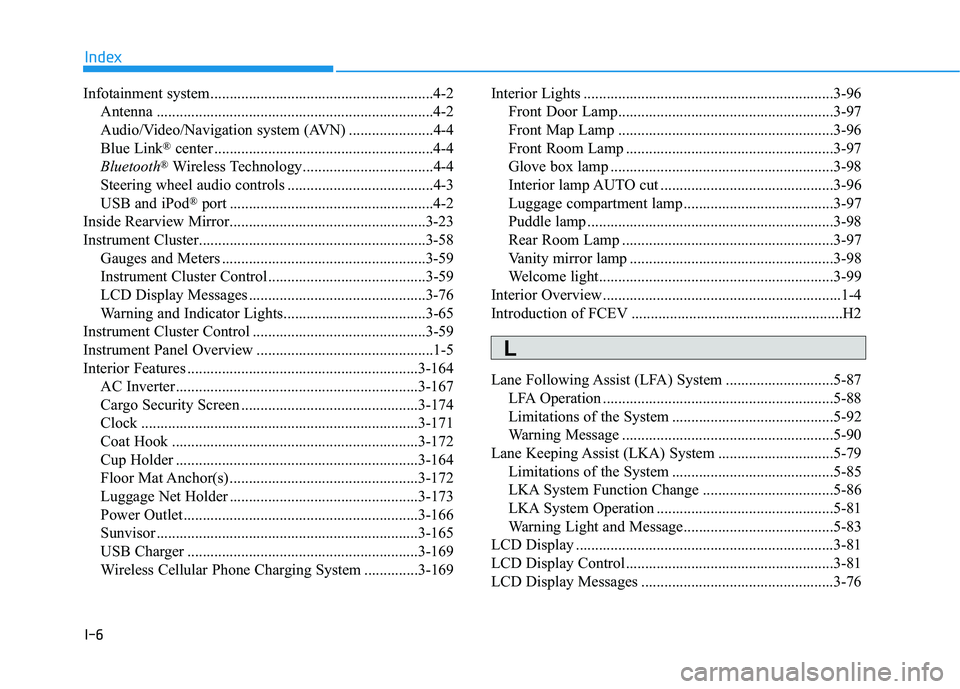
I-6
Infotainment system..........................................................4-2
Antenna ........................................................................4-2
Audio/Video/Navigation system (AVN) ......................4-4
Blue Link ®
center .........................................................4-4
Bluetooth ®
Wireless Technology..................................4-4
Steering wheel audio controls ......................................4-3
USB and iPod ®
port .....................................................4-2
Inside Rearview Mirror...................................................3-23
Instrument Cluster...........................................................3-58 Gauges and Meters .....................................................3-59
Instrument Cluster Control .........................................3-59
LCD Display Messages ..............................................3-76
Warning and Indicator Lights.....................................3-65
Instrument Cluster Control .............................................3-59
Instrument Panel Overview ..............................................1-5
Interior Features ............................................................3-164 AC Inverter...............................................................3-167
Cargo Security Screen ..............................................3-174
Clock ........................................................................3-171
Coat Hook ................................................................3-172
Cup Holder ...............................................................3-164
Floor Mat Anchor(s) .................................................3-172
Luggage Net Holder .................................................3-173
Power Outlet.............................................................3-166
Sunvisor ....................................................................3-165
USB Charger ............................................................3-169
Wireless Cellular Phone Charging System ..............3-169 Interior Lights .................................................................3-96
Front Door Lamp........................................................3-97
Front Map Lamp ........................................................3-96
Front Room Lamp ......................................................3-97
Glove box lamp ..........................................................3-98
Interior lamp AUTO cut .............................................3-96
Luggage compartment lamp .......................................3-97
Puddle lamp ................................................................3-98
Rear Room Lamp .......................................................3-97
Vanity mirror lamp .....................................................3-98
Welcome light.............................................................3-99
Interior Overview..............................................................1-4
Introduction of FCEV .......................................................H2
Lane Following Assist (LFA) System ............................5-87
LFA Operation ............................................................5-88
Limitations of the System ..........................................5-92
Warning Message .......................................................5-90
Lane Keeping Assist (LKA) System ..............................5-79
Limitations of the System ..........................................5-85
LKA System Function Change ..................................5-86
LKA System Operation ..............................................5-81
Warning Light and Message.......................................5-83
LCD Display ...................................................................3-81
LCD Display Control......................................................3-81
LCD Display Messages ..................................................3-76
Index
L